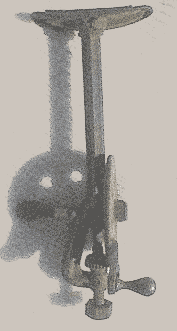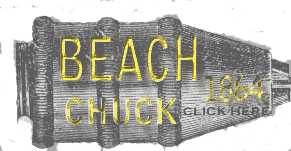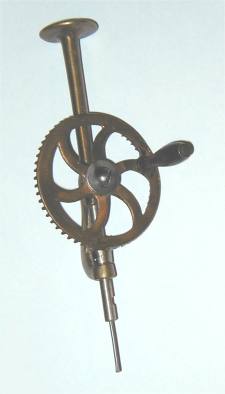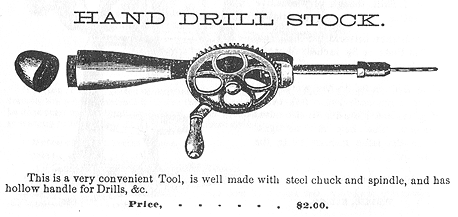 GEARED DRILLS
GEARED DRILLS
 GEARED DRILLS
GEARED DRILLS
Hand and Breast Drills
WARNING: This page has many jpegs and gifs and can take a few minutes to load completely with a 28.8 connection.
Previous to the development of geared drills most boring was done with t-augers, gimlets, pump and bow drills and braces. Though the hand and breast drills did not replace these their evolution went on into the 20th century long after new designs were conceived for the traditional boring tools. Geared drills were developed at the same time that machinery and processes were developed to mass produce metal parts to repeatable specifications. Certainly the bevel gears were copied from larger applications where this lower speed style gear was used.
The basic hand or breast drill transfers its power from a vertical hand cranked main gear to a horizontal pinion gear spinning on a shaft connected to a bit holding device. Depending on the size ratio of main gear to pinion a greater number of revolutions are achieved from one turn of the crank. The bit holding mechanism has evolved from a simple friction or thumbnut style to two and three jawed shell type chucks.
The two most common forms of bevel geared drills are the hand drill and the breast drill which are basically designated by their size. The larger breast drill has a curved plate or dome ,at the top, which allows the user to apply body weight to the boring process. The lighter hand drill allows a more precise drilling of smaller holes by allowing more direct downward pressure than could be achieved with a brace. I think that the first geared drills were used in drilling metal more than wood.
Three other forms of geared drills are:
The corner drill and brace. See George Langford's page on "Geared Braces-- Used Also as Corner Braces"
Blacksmiths drills (also known as post drills) I will provide some information on these in the future.
Boring machines --Here's one that is new to me. (Click) More to come later.
I have researched the origin of geared drills for the last few years with
little success. The
few smatterings of information that I gathered all turned out to be taken from
William Goodman's book "The History of Woodworking Tools" which is now out of
print. My copy is a 1976 printing. Goodman indicates that the earliest picture
of a geared drill appears in Bergeron's "L'Art du Tourneur" published in Paris in
1816. Goodman also notes that "in Holtzapfel (1846) it is called a "French
brace" I like Goodman's theory that geared drills probably originated in France perhaps as early as the end of the 1700's.
(1)
be taken from
William Goodman's book "The History of Woodworking Tools" which is now out of
print. My copy is a 1976 printing. Goodman indicates that the earliest picture
of a geared drill appears in Bergeron's "L'Art du Tourneur" published in Paris in
1816. Goodman also notes that "in Holtzapfel (1846) it is called a "French
brace" I like Goodman's theory that geared drills probably originated in France perhaps as early as the end of the 1700's.
(1)
The earliest of
these drills had simple methods of holding their bits. Generally these are
pictured (as patent drawings) with drill points. Examples are found
with the shell, center, spoon, nose or gimlet type bits in the chuck but I do
not believe that these were the bit of choice for these drills.
Often these tools are found with a drill point in the chuck. As
twist drills were developed the hand and breast drill with jawed chucks were the proper tools for
driving them. The early drills had a 1:1 gear ratio but this ratio grew until by
the 1860's many drills had a 4 to 1 ratio or greater. The frames were generally
a c-shaped design with turned wooden heads and wooden crank handles. Some had a
slightly different frame style, almost a J configuration. One that I have seen
on EBAY is marked "Germany" Goodman stated the earliest models did not have side
handles. I have two images here which can be "clicked" on to see a larger
version. The first has a picture of
 two of these early drills with the turned
wooden heads that are pretty standard in appearance. They are both 11 1/4 inches
tall.
two of these early drills with the turned
wooden heads that are pretty standard in appearance. They are both 11 1/4 inches
tall.
 The second picture is of a fancier model that I purchased from an English
tool dealer. At 10 1/2 inches tall the handle and heads are of a dark wood which
I think is ebony. The top of the head has an ivory ring around a brass
medallion. I have seen the same arrangement on Sheffield style braces. There is
a threaded hole for an auxiliary handle. I know that a lot of these that turn up
have been brought over from Europe in the last 10 years or so. I have never seen
one pictured in a tool catalog, European or otherwise. Were they also imported
to America and sold in quantities in the early 19th century? I don't know.
The second picture is of a fancier model that I purchased from an English
tool dealer. At 10 1/2 inches tall the handle and heads are of a dark wood which
I think is ebony. The top of the head has an ivory ring around a brass
medallion. I have seen the same arrangement on Sheffield style braces. There is
a threaded hole for an auxiliary handle. I know that a lot of these that turn up
have been brought over from Europe in the last 10 years or so. I have never seen
one pictured in a tool catalog, European or otherwise. Were they also imported
to America and sold in quantities in the early 19th century? I don't know.
One early reference is the 1838 price list of Wm H Carr and Co of Philadelphia. It is a text list with no images of "American Manufacturers Hardware &C." Mention is made of boring devices including gimlets, augers, drill stocks-iron with or without bows, and drill stock, patent . The last two items were in the section on hardware from Increase Wilson of the Wilson Manufactory of New London Conn. Wilson manufactured all sorts of hardware including one of the earliest brace patents, the Jeremy Taylor patent. Nowhere in the Carr list is any mention made of geared drills or breast drills.
 Here is a list of patents for geared
drills. I am still working on this but when done you should be able to search by
drill style (breast drill, hand drill etc.) patentee and patentee location. Most U.S. geared drill patents can be found under the patent
classification 81/34. (Straight stock having side driving gear) The earliest
geared drill patent is that of George Page of Keene NH.
(Patent #730 May 8, 1838) Mr. Page indicates that his patent is for
improvements to "geared drill stocks". Obviously geared drills were already
being sold in order for him to make improvements. Maybe we can draw a conclusion
that geared drills began to appear in the United States in the 1830's.
Here is a list of patents for geared
drills. I am still working on this but when done you should be able to search by
drill style (breast drill, hand drill etc.) patentee and patentee location. Most U.S. geared drill patents can be found under the patent
classification 81/34. (Straight stock having side driving gear) The earliest
geared drill patent is that of George Page of Keene NH.
(Patent #730 May 8, 1838) Mr. Page indicates that his patent is for
improvements to "geared drill stocks". Obviously geared drills were already
being sold in order for him to make improvements. Maybe we can draw a conclusion
that geared drills began to appear in the United States in the 1830's.
 The 1854 Chamberlain patent,
#10,499 illustrates a geared drill to indicate what his patent is not for. This
image is of a drill similar to the earliest European geared drills.
The 1854 Chamberlain patent,
#10,499 illustrates a geared drill to indicate what his patent is not for. This
image is of a drill similar to the earliest European geared drills.
 Chucks
designed for lathe applications began to be applied to drills in the 1860's.
Chucks
designed for lathe applications began to be applied to drills in the 1860's.
The Early American Industries Association's Chronicle of March 1982 has an article by Paul Kebabian, "A.W. Whitney Tinsmith's Tool Maker of Woodstock, Vermont." A photo shows a cast iron breast drill owned by Kebabian and marked "A.W. Whitney Woodstock, VT" The article included an 1856 advertising broadside for Whitney which listed the "drill stocks" available as "bright geared drill stock" or "green geared drill stock" This catalog clip from a circa 1865 Russell and Erwin hardware catalog shows the Whitney drills.

Click here to see an actual A. Whitney breast drill.
This same catalog showed the following geared drill:
This "geared brace" is also shown as a "corner brace" in the 1867 A.J. Wilkinson and Co's reprint. We follow with an actual picture of the drill from my collection.
I have seen at least 3 of this same drill offered on EBAY. I have also twice seen a variation with a curved "breast plate." The cranks have all been brass as with this drill. Notice that a provision is present for a side handle. My theory is that this is an earlier hand drill manufactured in the United States. I would not be surprised if this was manufactured by either The Wilson Manufactory or the White's of Hebron, CT. Notice the similarity between the iron top of this hand drill and the tops of the early patented braces. All of the European hand drills that I have seen have turned wooden heads.
Another drill
offered in the catalog is pictured here:

A similar
appearing drill in my collection:
This brass framed and geared drill is 6.5 inches tall with a 3" main gear.
The c. 1865 catalog also shows Wilson's Breast Drills:
Click here to see photos of what I believe is an Increase Wilson breast drill.
I am eager to find more information on Increase Wilson. I know that he was born c. 1786 in Connecticut, got married around 1802 and served in the War of 1812. He figured prominently in the manufacture of early boring tools including patented braces. A brace related patent holder, Charles Daboll, was said to be a foreman in Wilson's factory. Wilson passed on sometime in the 1840's but his products were still being sold at least as late as 1867 (shown in the A.J. Wilkinson and Co's reprint of that year)
Another drill shown in the Wilkinson Catalog is labeled "Hotchkiss' breast drill". They were listed in a #1 and #2 size. Patrick Leach offered one of these on his April 30th 2000 for sale list. He described it as: "this one has the original label on a gold painted breast plate; label reads "Smith's No.1 Hand Drills Hotchkiss Sons, Agts"; American-made, early, and in the same condition it was when made long ago, you'll never find another in this condition; " Jim Erdman and I both have 14plus inch versions of this drill but we are not sure whether these are #1's or #2's. If Patrick had indicated a size for the one he sold than we would have even more data from him. It is quick one line references like this that make dealers "for sale" lists a rich source for information. Here is a picture of the Hotchkiss drill I own.
It may have been more accurate for Wilkinson to title the catalog cut "Smith's breast drills". From Mr. Leach's description Hotchkiss was only the sales agent. Smith was the actual developer.
An 1870 J.M. Warren & Co. (Troy, N.Y.) catalog shows only two geared drills: an I. Wilson breast drill and another which is of fairly standard design possibly manufactured by the fledgling Millers Falls Manufacturing Co. Millers Falls grew from a partnership between Levi J. Gunn and Charles Amidon. They originally manufactured a clothes wringer but purchased the rights to the Barber brace and Roses Patent brace in 1864 and the rest is boring tool history. That history is reported most faithfully at Randy Roeder's website A Millers Falls Home Page . See the great information Randy has under hand drills. Also, George Langford has an excellent type study of the Millers Falls #2 hand drill.
The chuck used on
the early hand drills was patented by Henry L. Pratt in 1877. The earliest indication we have of Miller Falls producing geared
drills were those shown in the 1878 catalog reprint (from Phil Whitby). Pictured
are the #1 hand drill and a single breast drill. By the 1887 catalog they were
selling the #1, 2, 3 and 4 hand drills and breast drills numbered 10 thru 14. By
their 1915 catalog their inventory included 28 hand drills and 40 breast drills.
Surely they will stand forever as the premium manufacturer of boring tools. That
not withstanding , there is little information on or patents issued for their
earliest hand and breast drills. The 1867 A.J. Wilkinson & Co.'s catalog reprint
shows the Barber patent brace but no geared drills from Millers Falls. (they do
picture geared drills from Increase Wilson and other geared drills mentioned
above.) By the 1880's Millers Falls drills began cropping up in numerous
hardware catalogs.  The
1880 Jackson and Tyler catalog depicts the #12 breast drill and #1 hand drill.
They also picture another unrecognized hand drill. This drill has a hollow
upper handle and what appears to be a compression type chuck similar to those
used on the
Millers Falls #4 drill and the later Whitney patent jewelers drills.
The
1880 Jackson and Tyler catalog depicts the #12 breast drill and #1 hand drill.
They also picture another unrecognized hand drill. This drill has a hollow
upper handle and what appears to be a compression type chuck similar to those
used on the
Millers Falls #4 drill and the later Whitney patent jewelers drills.

Information presented here is copyright 2002 by Charles R. Zitur to the extent of original text and jpeg images of actual tools in the authors collection. Catalog cuts (mostly gif format) are scanned from actual and reprinted tool catalogs. Permission has been sought when possible and granted by all who responded.
Bibliography:
(1) The History of Woodworking Tools by W.L. Goodman Copyright 1964 G. Bell and Sons, LTD. London, England Reprint Published by David McKay Company, Inc page 181 "the earliest illustration of the breast drill......." to page 182 "......and one wonders how many are still in use today."